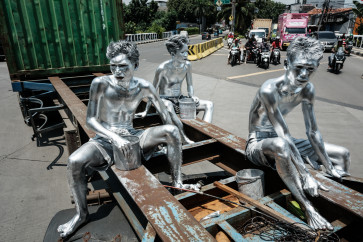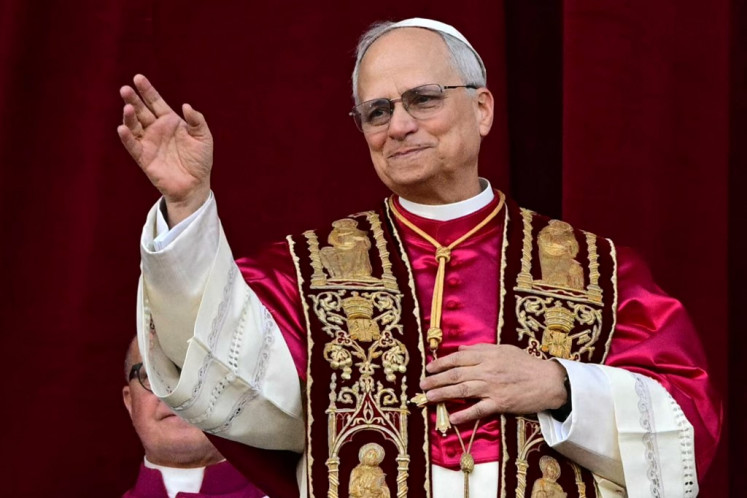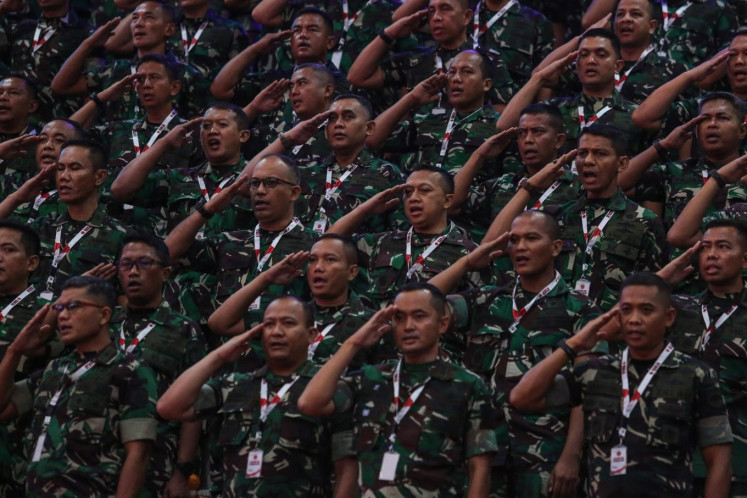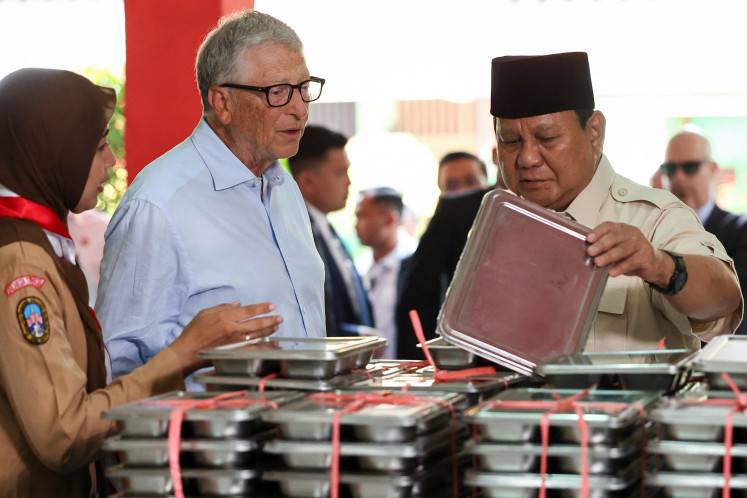At least 125 killed in soccer stampede
Eyes on police use of force in Malang stadium tragedy.
Change text size
Gift Premium Articles
to Anyone

A
t least 125 people were killed, and a hundred more were injured, in a stampede after a soccer match in Malang regency, East Java, on Saturday night, in Indonesia's worst-ever stadium incident. Tens of thousands of fans rushed out of the stadium when police fired tear gas, a move that critics have deemed excessive and the main cause of the stampede.
The deadly incident took place after home team Arema FC lost 3-2 in a top league Liga 1 match against their regional rival, Persebaya Surabaya, at the Kanjuruhan Stadium. In a classic display of rowdy Indonesian sports fans, the home crowd, nicknamed Aremania, took to the pitch to express their frustration.
Out of the 40,000 people in attendance, around 3,000 rushed to the pitch while the rest remained at the stands, East Java Police chief Inspector General Nico Afinta told a press conference on Sunday morning.
“In response, we did some crowd control measures, including using tear gas, as they had started to engage in anarchic behavior. They had started attacking the police and had vandalized police vehicles,” he said.
The tear gas incited hysteria among the crowd and they rushed for the exit, resulting in a stampede and pile-ups by the exit. This, according to Nico, was when some members of the crowd started to suffocate due to the lack of oxygen, and the chaos resulted in the immediate deaths of 34 people, while the rest died on the way to or while being treated at the nearest hospitals.
National Police chief Gen. Listyo Prabowo confirmed the 125 casualties on Sunday evening, revising an earlier estimate by the Malang Disaster Mitigation Agency that pegged the death toll at 174.
Nico insisted that had the crowd remained civil, the police would not have resorted to such drastic actions. But many critics and human rights organizations pointed out the police’s choice of using tear gas, which has been banned by world soccer's governing body FIFA, as the main culprit behind the deadly stampede.
Tear gas misuse
Muhamad Isnur of Indonesia Legal Aid Foundation (YLBHI) condemned the police’s excessive use of force. “The footage we’ve seen shows the police using violence to handle the crowd and as they took to the pitch, the police fired tear gas into the stands, which were still filled with people at the time,” Isnur said in a statement.
He cited FIFA’s stadium safety regulations which state that “no firearms or crowd control gas” should be carried or used by stewards or police inside a stadium.
The problem, according to Edi Priyanto of the East Java Occupational Health and Safety (K3) Experts Association, was if the organizer decided to ignore FIFA’s regulations.
“Every public facility meant to host large masses of people has to prepare an Emergency Response Plan [ERP] in anticipation of riots and other emergencies [...],” Edi told The Jakarta Post. “FIFA even mandates such an ERP in stadium contingency plans.”
Amnesty International Indonesia director Usman Hamid compared the Kanjuruhan stampede to the Peru soccer disaster of 1964, “where more than 300 people died after police fired tear gas into the crowd, starting a pile-up which resulted in suffocation among the crowd”.
The Peru case remains the worst soccer-related disaster in history with 326 casualties. The Kanjuruhan stampede, with the death toll currently at 125, is now ranked third worst in world history, and the worst in Asia.
While Usman was aware of the complex situation facing the police, he urged them to always respect the rights of everyone involved, including rioters. Both Isnur and Usman urged the government to investigate allegations of excessive use of force and potential human rights violations conducted by the police.
Official response
The Soccer Association of Indonesia (PSSI) suspended all games in Liga 1 for a week, starting on Sunday.
PSSI chairman Mochamad Iriawan named Aremania and Arema FC as the culprit, and has promised sanctions against the club, kompas.id reported.
However, Coordinating Political, Legal and Security Affairs Minister Mahfud MD instead called on the organizer of Liga 1 -- PT Liga Indonesia Baru (LIB) -- to take responsibility. The police had already requested the match be moved to earlier in the day and the number of tickets capped at 38,000, in line with the Kanjuruhan Stadium’s maximum capacity, citing security issues.
“But [LIB] refused to grant these requests. The match still went ahead in the evening, and the number of tickets sold was 42,000,” Mahfud said.
Hadi Santoso, an observer of the East Java soccer scene, told the Post that high-profile derby matches in Europe were usually held earlier in the day, too. “Why hold the match in the evening? Evening matches are always riskier. And the East Java Derby between Arema and Persebaya is especially intense.”
President Joko “Jokowi” Widodo has also taken a harsher stance, ordering an investigation into the tragedy, a “thorough evaluation on how football matches are managed and the security measures” and asking the PSSI to suspend the league indefinitely until evaluation and security improvements had been completed.
The disaster has called into question Indonesia’s status as the host of the 2023 FIFA U-20 World Cup, which is slated to begin in May of next year. Indonesia was originally set to host the 2021 edition of the biannual youth soccer tournament, which was postponed until 2023 because of the COVID-19 pandemic.
FIFA has handed down sanctions before on soccer-related disasters. In the aftermath of the Heysel Stadium disaster in 1985, FIFA banned all English clubs from participating in worldwide competitions, extending a Europe-wide ban that was put in place by European football’s governing body UEFA.









